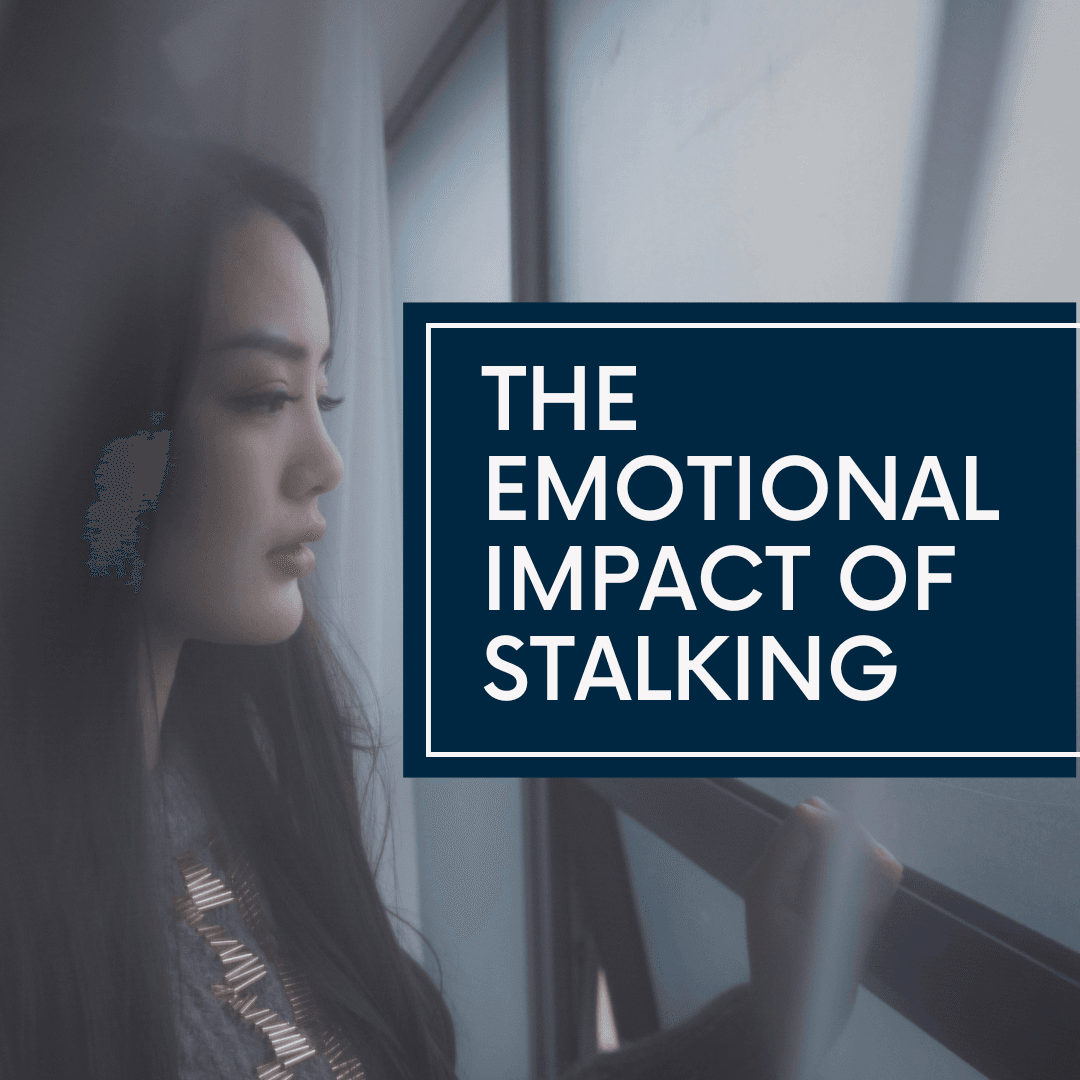
Abby Neef
Advocate
Faces of Hope
Stalking is a serious problem affecting many people, more commonly women. Stalking can occur in many different social associations, such as intimate partners, relatives, acquaintances and strangers. Stalking causes a variety of negative consequences, such as emotional and financial problems. Even though we understand more about it now, studying stalking is still relatively new. It became a crime in the ’90s after some high-profile cases, like actress Rebecca Shaffer’s murder. While we know stalking causes emotional distress, we’re still figuring out how it affects people’s emotions in relation to the direct relationship between the stalker and the victim.
Defining stalking can be tough to report because it’s similar to harassment. Stalking differs from harassment when it’s directed at one person, repeatedly, making them feel unsafe. Sometimes, what a victim determines to be stalking might not be seen that way by the law, affecting how many cases are reported.
Researchers have tried to sort stalkers into groups based on their relationship with the person they’re stalking. Researchers found that being stalked by a current or past intimate partner is considered the most dangerous cases.
The Emotional Toll
Stalking can really mess with how someone feels. It can make them feel scared, stressed, sad, and even physically sick. Some studies show that people who are stalked have trouble sleeping and might even think about hurting themselves. Different stalking actions trigger varied negative emotions, with intensifying stalking associated with increased distress and violence risks. Longer stalking durations, notably in ex-partner cases, correlate with heightened stress levels.
Researchers want to learn more about how the relationship between the stalker and the person being stalked influences the emotional toll. They looked at lots of people who went through stalking and found that those stalked by current partners were in the highest distress, followed by people stalked by ex-partners. Others, like friends or strangers, showed lower distress, however it is important to note that the levels of emotional distress are substantial. Even after considering things like age, gender, and where they live, the relationship between the stalker and the person being stalked still mattered.
Understanding how relationships play a role in stalking is really important, especially for helping those going through it. It can help make sure they get the right kind of help and support. Stalking can really mess with how someone feels, and knowing more about it can help make things better for those going through it. Tailored support and empathy in criminal justice responses make a difference.
How you can help
Offering support to someone dealing with stalking can make a significant difference in their situation. Take their concerns seriously and listen without judgment. Help them keep a detailed record of all stalking instances and incidents – emails, texts, and social media messages included. These can be crucial for a protection order.
If you’re in Boise, please encourage them to reach out to Faces of Hope for emotional support, safety planning, legal guidance, and resources like video doorbells and pepper spray. However, please respect their privacy and don’t speak to law enforcement without their consent if they do not wish to report. This is one way you can give back control to the victim. Overall, regular check-ins help them feel safer and supported. It takes all of us to help victims of stalking navigate a path forward.
This blog post is a condensed version of my BSU master’s thesis entitled “Stalking Victimization: Examining the Influence of Victim-Offender Relationship on Victim Emotional Distress.”
References and further research:
Amar, A. F. (2006). College women’s experience of stalking: Mental health symptoms and changes in routines. Archives of Psychiatric Nursing, 20. 108-116.
Beatty, D. (2003). Stalking legislation in the United States. In M. Brewster (Ed.), Stalking: Psychology, risk factors, interventions and law. (pp.21-55). Kingston, NJ: Civic Research Institute.
Ben, K. D. (2000). Stalking: Developing an empirical typology to classify stalkers. (Publication No. 1404602) [Master’s thesis, West Virginia University] UMI publishing
Bjerregaard, B. (2000). An empirical study of stalking victimization. Violence and Victims, 15(4), 389–406.
Blaauw, E., Winkel, F. W., Arensman, E., Sheridan, L., & Freeve, A. (2002). The Toll of Stalking: The Relationship Between Features of Stalking and Psychopathology of Victims. Journal of Interpersonal Violence, 17(1), 50–63. https://doi.org/10.1177/0886260502017001004
Brewster, M. P. (2000). Stalking by former intimates: Verbal threats and other predictors of physical violence. Violence and Victims, 15, 41-54.
Catalano, S. (2012). Stalking victims in the United States–Revised. Washington, DC: U.S. Department of Justice, Bureau of Justice Statistics.
Davis, K. E., Coker, A. L., & Sanderson, M. (2002). Physical and mental health effects of being stalked by men and women. Violence and Victims, 17(4), 429–443. https://doi.org/10.1891/vivi.17.4.429.33682
Hanson, R. F., Sawyer, G. K., Begle, A. M., & Hubel, G. S. (2010). The impact of crime victimization on quality of life. Journal of Traumatic Stress, 23(2), 189–197. https://doi-org.libproxy.boisestate.edu/10.1002/jts.20508
Johnson, M. C., & Kercher, G. A. (2009). Identifying Predictors of Negative Psychological Reactions to Stalking Victimization. Journal of Interpersonal Violence, 24(5), 866–882. https://doi.org/10.1177/0886260508317195
Kraaij, V., Arensman, E., Garnefski, N., & Kremers, I. (2007). The Role of Cognitive Coping in Female Victims of Stalking. Journal of Interpersonal Violence, 22(12), 1603–1612. https://doi.org/10.1177/0886260507306499
Kurt, J. L. (1995). Stalking as a variant of domestic violence. Bull American Academy Psychiatric Law. 23(2). 219-230.
Logan, T. K. (2019). Examining stalking experiences and outcomes for men and women stalked by (ex)partners and non-partners. Journal of Family Violence. 35. 729-739
Logan, T. K., Shannon, L. & Cole J. (2007). Stalking victimization in the context of intimate partner violence. Violence and Victims, 22(6)
Logan, T. K. & Walker R. (2010) Toward a deeper understanding of the harms caused by partner stalking. Violence and Victims. 25(4). doi:10.1891/0886-6708.25.4.440
Maran D. A. & Varetto A. (2018) Psychological impact of stalking on male and female health care professional victims of stalking and domestic violence. Frontiers in Psychology. 9(321). doi:10.3389/fpsyg.2018.00321
Max, W., Rice, D. P., Finkelstein, E., Bardwell, R. A., & Leadbetter, S. (2004). The economic toll of intimate partner violence against women in the United States. Violence and Victims. 19, 259-272. doi:10.1891/vivi.19.3.259.65767
McEwan T. E., Mullen P., Purcell R. (2007). Identifying risk factors in stalking: A review of current research. International Journal of Law and Psychiatry. 30, 1-9
McKeon B., McEwan T. E. & Luebbers S. (2014). “It’s not really stalking if you know the person”: Measuring community attitudes that normalize, justify, and minimize stalking. Psychiatry, Psychology, and Law. Doi: 10.1080/13218719.2014.945637
Mechanic M. B., Weaver T. L. & Resick P. A. (2000). Intimate partner violence and stalking behavior: Exploration of patterns and correlates in a sample of acutely battered women. Violence and Victims. 15(1).
Meloy, J. R. (1998). The psychology of stalking: Clinical and forensic perspectives. Academic Press. https://doi.org/10.1016/B978-012490560-3/50020-7
Menard K. S. & Cox A. K. (2016) Stalking victimization, labeling, and reporting: Findings from the NCVS stalking victimization supplement. Violence Against Women, 22(6), 671-691 Doi: 10.1177/1077801215610862
Miller L. (2012) Stalking: Patterns, motives, and intervention strategies. Aggression and Violent Behavior. 17. 495-506. Doi: 10.1016/j.avb.2012.07.001
Mohandie, K., Meloy, J. R., McGowan, M. G., & Williams, J. (2006). The RECON typology of stalking: reliability and validity based upon a large sample of North American stalkers. Journal of Forensic Sciences, 51(1), 147–155. https://doi.org/10.1111/j.1556-4029.2005.00030.x
Morgan R. E., & Truman J. L. (2022). Stalking victimization, 2019. U.S. Department of Justice.
Mullen P. E., Pathe M, Purcell R., Stuart G. W. (1999) Study of stalkers. Am J Psychiatry. 156(8). 1244-1249
Mustaine, E. E. (2010). Stalking. In B. S. Fisher & S. P. Lab (Eds.), Encyclopedia of victimology and crime prevention. 2. 900–904. Thousand Oaks, CA: Sage.
NCVS. (2019). National Crime Victimization Survey: Supplemental Victimization Survey. (ICPSR 37950) [codebook]. ICPSR.
Ngo, F.T., Paternoster, R. (2013). Stalking Strain, Concurrent Negative Emotions, and Legitimate Coping Strategies: A Preliminary Test of Gendered Strain Theory. American Journal of Criminal Justice. 38, 369–391. https://doi.org/10.1007/s12103-012-9179-x
Ngo, F.T.& Paternoster, R. (2016). Toward an understanding of the emotional and behavioral reactions to stalking: A partial test of general strain theory. Crime and Delinquency. 62(6). 703-727
Norris, S. M., Huss M. T. & Palarea R. E. (2011). A pattern of Violence: Analyzing the relationship between intimate partner violence and stalking. Violence and Victims. 26(1). Doi:10.1891/0886-6708.26.1.103
Owens J. G. (2017) A gender-biased definition: Unintended impacts of the fear requirement in stalking victimization. Crime and Delinquency. 63(11) 1339-1362. Doi: 10.1177/0011128715615883
Owens J. G. (2016). Why definitions matter: stalking victimization in the United States. Journal of Interpersonal Violence. 31(12). 2196-2226. Doi: 10.1177/0886260515573577
Pathe, M., & Mullen, P. E. (1997). The impact of stalkers on their victims. The British Journal of Psychiatry. 170(1), 12-17.
Purcell R., Pathe M., Mullen P. E. (2008) Harm associated with stalking victimization. Australian and New Zealand Journal of Psychiatry. 42(9). 800-806
Racine C. & Billick S. (2014). Classification systems for stalking behavior. Journal of Forensic Sciences. 59(1). 250-254. Doi: 10.1111/1556-4029.122262
Rosenfeld, B. (2004). Violence risk factors in stalking and obsessional harassment: A review and preliminary meta-analysis. Criminal Justice and Behavior. 31(1) Doi: 10:1177/0093854803259241
Senkans, S., McEwan T. E. & Ogloff J. R. P. (2021) Assessing the link between intimate partner violence and post-relationship stalking: A gender-inclusive study. Journal of Interpersonal Violence. 36(1-2). Doi:10.1177/0886260517734858
Sheridan L., Blaauw E., Davies G. M. (2003). Stalking: Knowns and unknowns. Trauma, Violence and Abuse. 4(2). Doi:10.1177/1524838002250766
Sheridan L., Davies G., & Boon J. (2001) The course and nature of stalking: A victim’s perspective. The Howard Journal, 40(3). 215-234
Sheridan L., Lyndon A. E. (2012). The influence of prior relationship, gender and fear on the consequences of stalking victimization. Sex Roles. 66. 340-350. Doi: 10.1007/s11199-010-9889-9
Spitzberg, B. H., Cupach, W. R., & Ciceraro, L. D. L. (2010). Sex Differences in Stalking and Obsessive Relational Intrusion: Two Meta-Analyses. Partner Abuse, 1(3), 259-285. https://doi.org/10.1891/1946-6560.1.3.259
Stewart M. C. (2011). The effects of victimization on women’s health: Does the victim-offender relationship matter? [Doctoral dissertation, University of Cincinnati].
Subramanian, N. B. (2021, June 27). 5 assumptions made by OLS: Python. AI ASPIRANT. Retrieved April 22, 2023, from https://aiaspirant.com/ols-assumptions
Tjaden, P., Thoennes, N. & Allison, C. J. (2000) Comparing stalking victimization from legal and victim perspectives. Violence and Victims. 15(1)
Tjaden, P. & Thoennes, N. (2000). Prevalence and Consequences of Male-to-female and Female-to-male Intimate Partner Violence as Measured by the National Violence Against Women Survey. Violence Against Women, 6(2), 142–161. https://doi.org/10.1177/1077801002218176
Tjaden P., & Thoennes, N. (1998). Stalking in America: Findings from the National Violence Against Women Survey (NCJ 169592).
Truman J. L., & Morgan R. E. (2016). Stalking victimization, 2016. U.S. Department of Justice.
United States. Bureau of Justice Statistics. National Crime Victimization Survey: Supplemental Victimization Survey, [United States], 2019. Inter-university Consortium for Political and Social Research [distributor], 2021-04-15. https://doi.org/10.3886/ICPSR36841.v1
Worsley, J. D., Wheatcroft, J. M., Short, E., & Corcoran, R. (2017). Victims’ Voices: Understanding the Emotional Impact of Cyberstalking and Individuals’ Coping Responses. SAGE Open. https://doi.org/10.1177/2158244017710292
Zona, M. A., Sharma, K. K., & Lane, J. (1993). A comparative study of erotomaniac and obsessional subjects in a forensic sample. Journal of Forensic Sciences. 38(4), 894–903.



